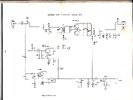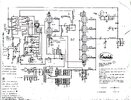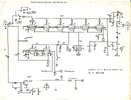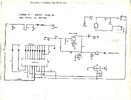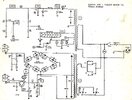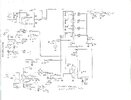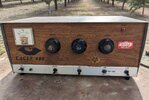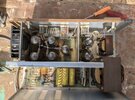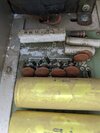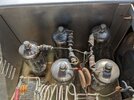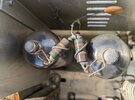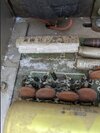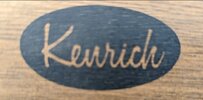The tall tubes were european-made. One way to tell is to look at the glass on top. If the glass has an uninterrupted smooth surface all the way around it was probably from a USA factory. For some reason, european tube manufacturers would fold the top of the glass down to close the top leaving four raised seams visible in the glass around the plate cap. The glass was thicker than the american types, to boot.
Somebody on this side of the Atlantic ocean painted/printed the Ken-Rich brand/logo on the tubes installed at the factory. The story I was told is that the 27LF6 was available in quantity in the early 80s. Went cheap since there were no color TVs sold in the USA that used it for the sweep amplifier. No demand for that number as a repair part. Only european TV receivers ever used this tube. A tube that's available in bulk for cheap is an irresistible incentive if you're building amplifiers with them. But the arithmetic is just all wrong for five times twenty when you put 125 Volts on a five-tube final stage's heaters.
Kinda like a nitrous bottle, but without the "off" switch. Does make the wattmeter incredibly happy.
For a while.
Don't know why, but this, uh, "imbalance" seems to roast the two driver tubes first. Then again, they get their heater supply from a 30-Volt transformer secondary. First hint of this is frequently the plate choke for the two driver tubes when it roasts.
In the late 80s I would get calls looking for the 27LF6 tube. More than one customer had called a supply house and got told "that number isn't on our list". GE stopped showing it on their price lists around 1985, if not sooner.
Sure wish I could remember the european number for it.
There was one other advantage to the original tube. It was designed for use in a TV running from a 240 Volt wall socket.
Not 120 Volts. The insulation between the heater and the tube's cathode in the american-made tube would break down. But the european tubes would not.
This only seemed to happen in the five final tubes. The heater-to cathode RF voltage is added on top of the AC line voltage to ground. Those two voltages add up to a bigger number on the final tubes. The driver tubes have only the radio's RF voltage driving the cathodes. The final stage has the output of the two driver tubes' RF votlage on its cathode. I was told the european tube had to have better insulation so they could operate from twice the wall-outlet voltage.
I remember a few of these amplifiers we saw with a toroid RF choke installed between the two foil pads on the PCB that feed into the five heaters' series string. I don't exactly see how that would help, but it didn't seem to hurt anything.
Had a customer who tracked down his own 27LF6 tubes. Was sharp enough to buy a couple of spares. Good thing, since one tube went "SNAP,flash" under test. Left him one spare that matched the other four finals.
The performance of the glass-factory era base amplifiers depended in a big way on tubes with a perfect quality level. Tubes made in the era of high production-run quantities just had a higher average quality level than tubes made years later in shorter production runs. Might take you ten or twelve late-production tubes to obtain eight tubes that perform like "the old days".
But hey, it's only money.
73

